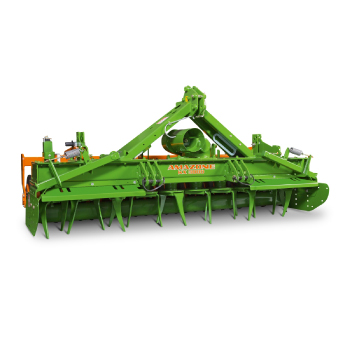A matter of cleanliness
The use of steel abrasives in agricultural engineering
Mention agricultural soil cultivating machines, and the image that automatically comes to mind is a machine that has to battle its way through soil, dirt and clay. However, the importance of cleanliness during the production of these machines is not up for debate at BBG Bodenbearbeitungsgeräte Leipzig GmbH & Co. KG, a subsidiary of the Amazone Group in Leipzig.
“We need our workpieces to have clean surfaces in order to enable paints and coatings to be properly applied later on”, explains Peter Sambale, Head of Quality Management at BBG. The cleanliness of all surfaces to be machined has been particularly important to the company that has specialised in the manufacture of towed soil cultivating machines and crop protection sprayers since 2005. During that year, environmental legislation for the reduction of solvents in paints and coatings (VOCs) came into force. For BBG, that meant having to reduce its solvent consumption to considerably less than 15 tonnes per annum. Trials using coatings with a lower solvent content proved unsuccessful. The long drying time and inferior quality of application were unacceptable for BBG. So another approach had to be taken. “The cleanliness of the surfaces to be coated has a determining influence on the solvent content of the base coat so we were able to improve our VOC levels by optimising our precleaning processes”, says Sambale.
The different states in which the steel arrives in Leipzig constitute the main problem. But the surfaces need to be clean not just so that they can be coated but also so that they can be welded, as the welding robots used need conditions to remain as constant as possible. Otherwise, different resistances caused by the surfaces not being cleaned properly can cause arc breakages which can result in the disruption of the welding process. In addition, rust, scale and oil can cause inadmissible weld flaws (cracks and pores). Sharp edges – so-called “slag beards” – and scale on the cutting surface that can be caused by plasma cutting also have to be removed before further processing is carried out.
BBG has a roller conveyor blast machine for removing scale and rust. In order to achieve optimal results with this machine, various series of tests were carried out at the beginning of the year over a period of several months under the same conditions using two different steel shot abrasives. Tests were carried out using workpieces typical of the ones machined by BBG.
Frank Meißner, foreman at BBG, was eager to see optimum results, not only to make the subsequent task of paint application easier but also to save time during further processing: “We used plasma-cut workpieces, profiles heavily coated with scale and thin laser-cut sheets for our tests.” The degree of cleaning achieved as well as the amount of abrasive used and machine wear in relation to number of workpieces blasted were assessed. Any deformation (in respect of flatness) of the thinner parts with the same blast parameters (position, belt speed + wheel speed of rotation) was also determined.
After the various series of tests had been carried out, BBG made the decision to stick with S390 abrasive produced by Ervin AMASTEEL. Compared with the low carbon steel abrasive, the Leipzig company found AMASTEEL to be preferable in various respects. Frank Meißner discovered that better results were achieved with all the workpiece surfaces cleaned by being blasted with AMASTEEL product. The final report stated the following: “The steel abrasive produced by Ervin AMASTEEL is harder, and more efficient energy transfer is achieved during blasting. A higher level of deformation was not found to have occurred in the thinner pieces. It removes rust and scale more thoroughly and quickly and has a longer service life in respect of the numbers of workpieces blasted”.
It was also emphasised that Ervin AMASTEEL steel shot was much more uniform in terms of shape and size than the competitive product tested. This fact also contributes towards ensuring a noticeable reduction in the amount of blast abrasive used.
So as far as the Maintenance and Quality Assurance teams at BBG were concerned, there was no question as to which product they should choose, and they naturally went for Ervin AMASTEEL abrasive. Plant manager Jorg Pollex didn’t need much convincing: “In this case, the factors which played a decisive role in shaping our decision were economy, time and quality.”
BBG Bodenbearbeitungsgeräte Leipzig GmbH & Co. KG
www.bbg-leipzig.de
Ervin AMASTEEL
www.ervinamasteel.eu



